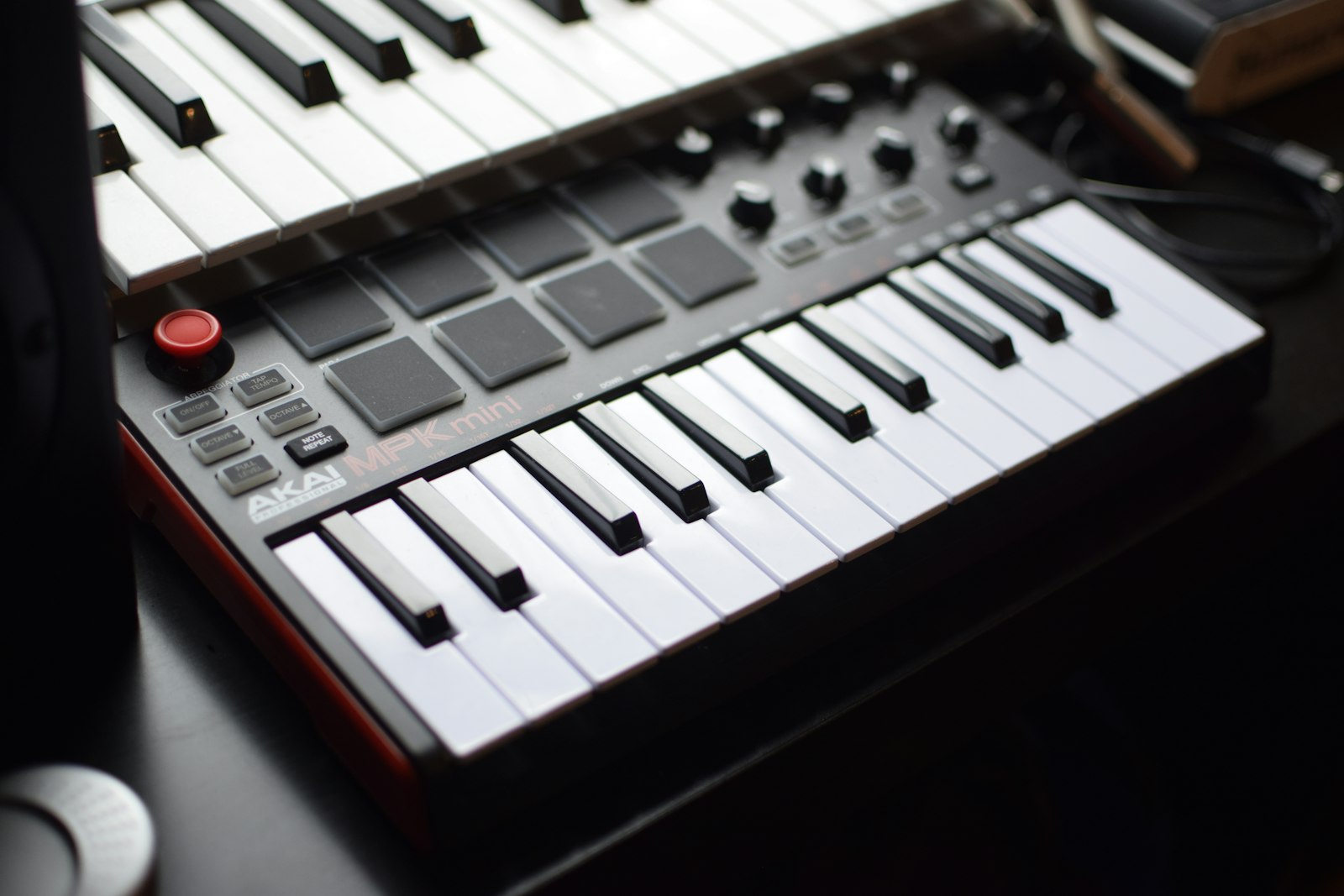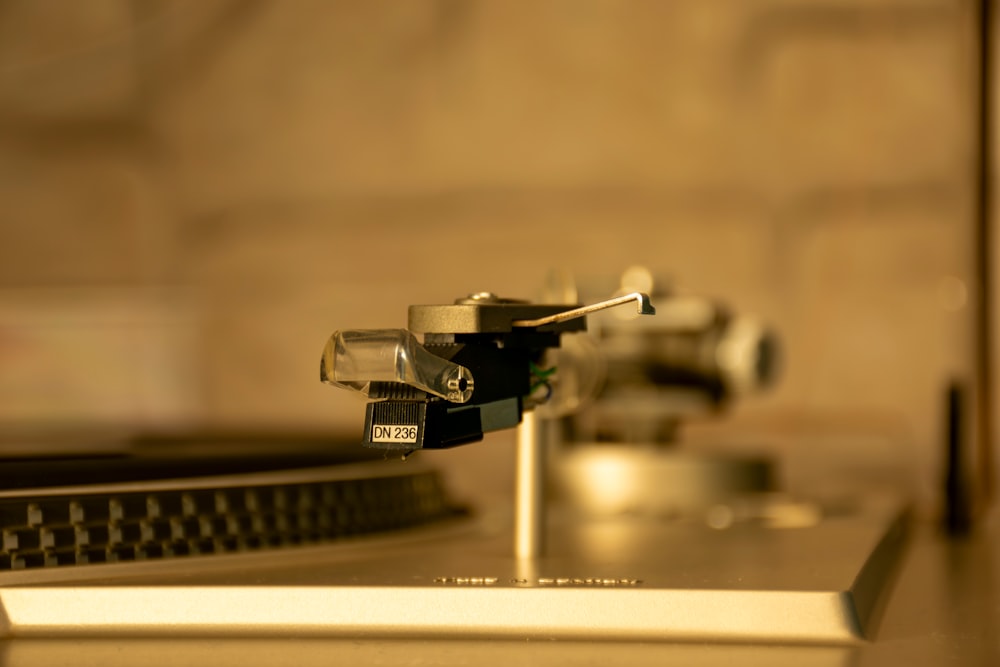A MIDI keyboard, or controller, is an essential piece of equipment in music production that allows you to input musical note and controller data into a digital audio workstation (DAW). It's pivotal for creating, editing, and performing music digitally, making it a cornerstone in music production.
What does a MIDI Keyboard do?
A MIDI keyboard is a dynamic interface for music production, translating physical actions into a language that DAWs understand.
Unlike traditional keyboards that produce sound directly, MIDI keyboards send MIDI data to computers or sound modules, which then use this information to generate sound or control software.
The functionality of MIDI keyboards extends beyond simple note entry, embracing a wide array of musical expressions and control capabilities:
Core MIDI Messages
- Note-on and note-off messages. These fundamental messages communicate when a key is pressed and released.
- Velocity. A key component of MIDI data, velocity measures the speed at which a key is pressed, influencing the volume and attack of the note. This allows you to convey dynamics and intensity in your performances.
Extended MIDI Controls
- Aftertouch. After a note is pressed, applying additional pressure can send aftertouch messages, offering another dimension of expression. Depending on how it's mapped within the software or synthesizer, aftertouch can modulate various parameters like vibrato, volume, or filter intensity.
- Pitch bend. Typically controlled by a wheel or lever on the MIDI keyboard, pitch bend messages allow for smooth transitions between notes, emulating techniques like string bends on a guitar or glissando on a piano.
- Modulation. Often assigned to a wheel or a separate control, modulation messages can dynamically alter sound characteristics, such as vibrato depth, LFO rate, or filter sweeps, adding texture and movement to the sound.
- Program change. These messages enable the selection of different instruments or sounds (patches) directly from the MIDI keyboard, facilitating quick changes during performance or production without interacting with the computer or module.
Benefits
- Versatility. MIDI keyboards can control virtually any element within a DAW, from playing virtual instruments to adjusting volume sliders or applying effects.
- Expressiveness. With velocity-sensitive keys and additional control features like pitch bend and modulation wheels, MIDI keyboards offer nuanced expressiveness in digital music creation.
- Workflow efficiency. MIDI keyboards streamline the music production process, enabling quick input of musical ideas and facilitating the editing and arrangement phases.
Types of MIDI Controllers
MIDI controllers are tailored to suit various music production and performance needs, categorized by their design and functionality. Here’s a breakdown of each type:
Keyboard Controllers
Mini Keyboard Controllers
- Features: Ultra-portable with 25 to 32 mini keys, making them perfect for musicians on the move or those with limited workspace.
- Pros: They offer affordability and convenience without sacrificing functionality, ideal for sketching out musical ideas wherever inspiration strikes.
- Cons: Smaller keys may provide a different feel or playability than full-size keys, potentially challenging for traditional pianists.
- Example: AKAI MPK Mini
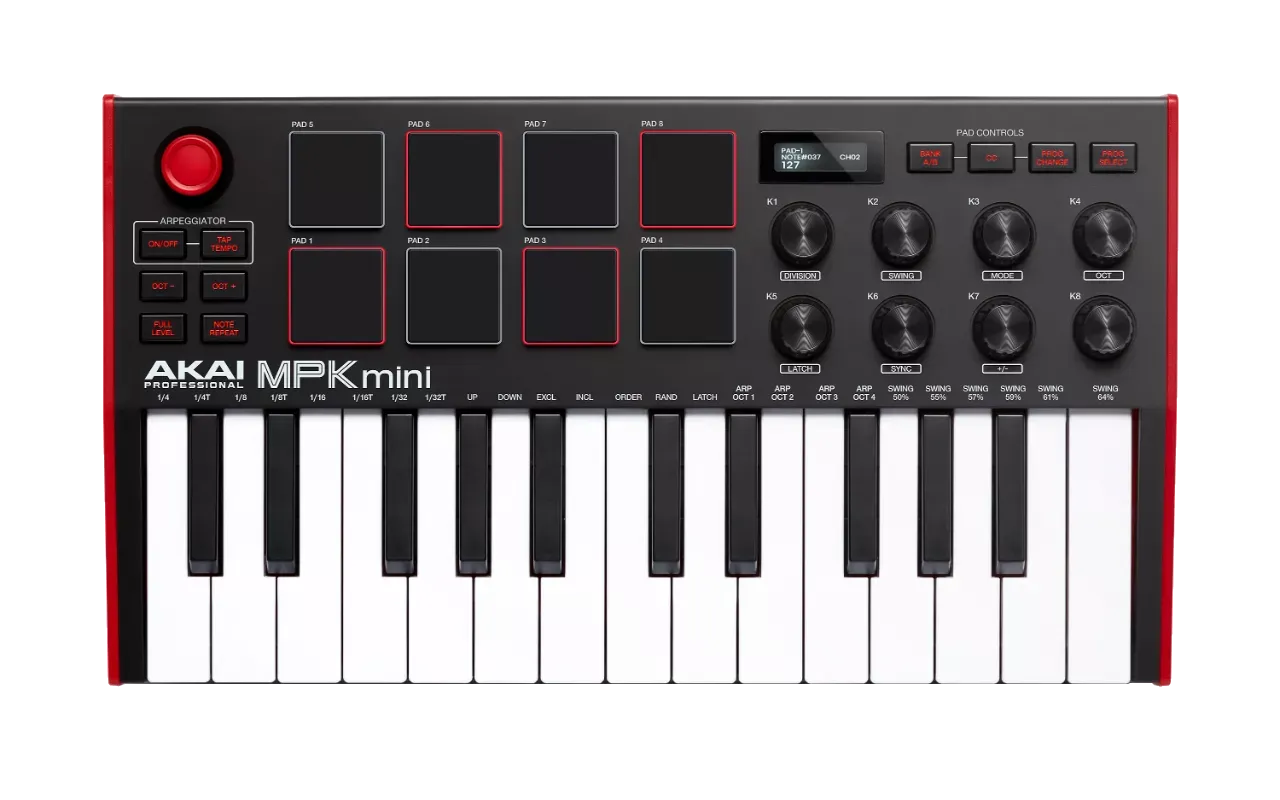
Full-Size Keyboard Controllers
- Features: With a range of 49 to 88 keys, these controllers emulate the span of an acoustic piano, catering to more complex musical compositions.
- Pros: They are the go-to choice for professional studio work, offering extensive note ranges necessary for more intricate pieces or performances.
- Cons: Their larger footprint and higher cost make them less portable and require more investment in both space and money.
- Example: Arturia KeyLab Essential 88

Pad Controllers
- Features: Designed primarily for triggering samples, loops, or beats, pad controllers are ideal for beat-making and electronic music production.
- Pros: The tactile pads enable dynamic and rhythmic input, enhancing creativity in drum programming and live performance settings.
- Cons: They lack the capability for melodic input, limiting their use to rhythmic and sampling tasks.
- Example: Ableton Push 2
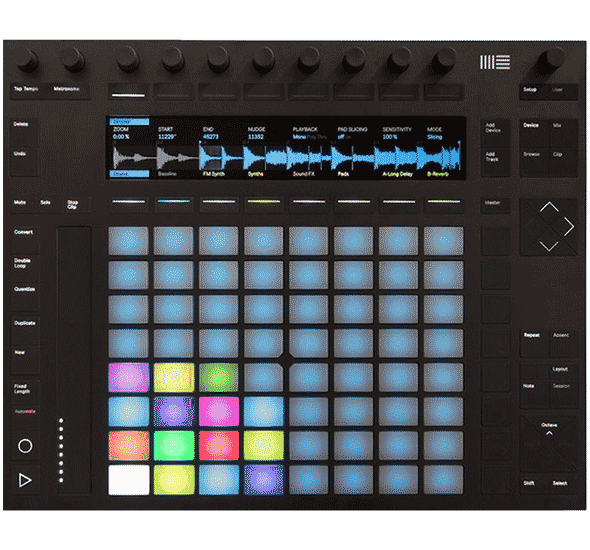
Fader and Knob Controllers
- Features: Equipped with sliders, knobs, and transport controls, these controllers excel in mixing, mastering, and adjusting sound parameters within a DAW.
- Pros: They provide precise control over mixing and sound adjustments, crucial for fine-tuning tracks to perfection.
- Cons: Without traditional note input methods, they're best used alongside other MIDI devices for a complete production setup.
- Example: Novation Launch Control XL
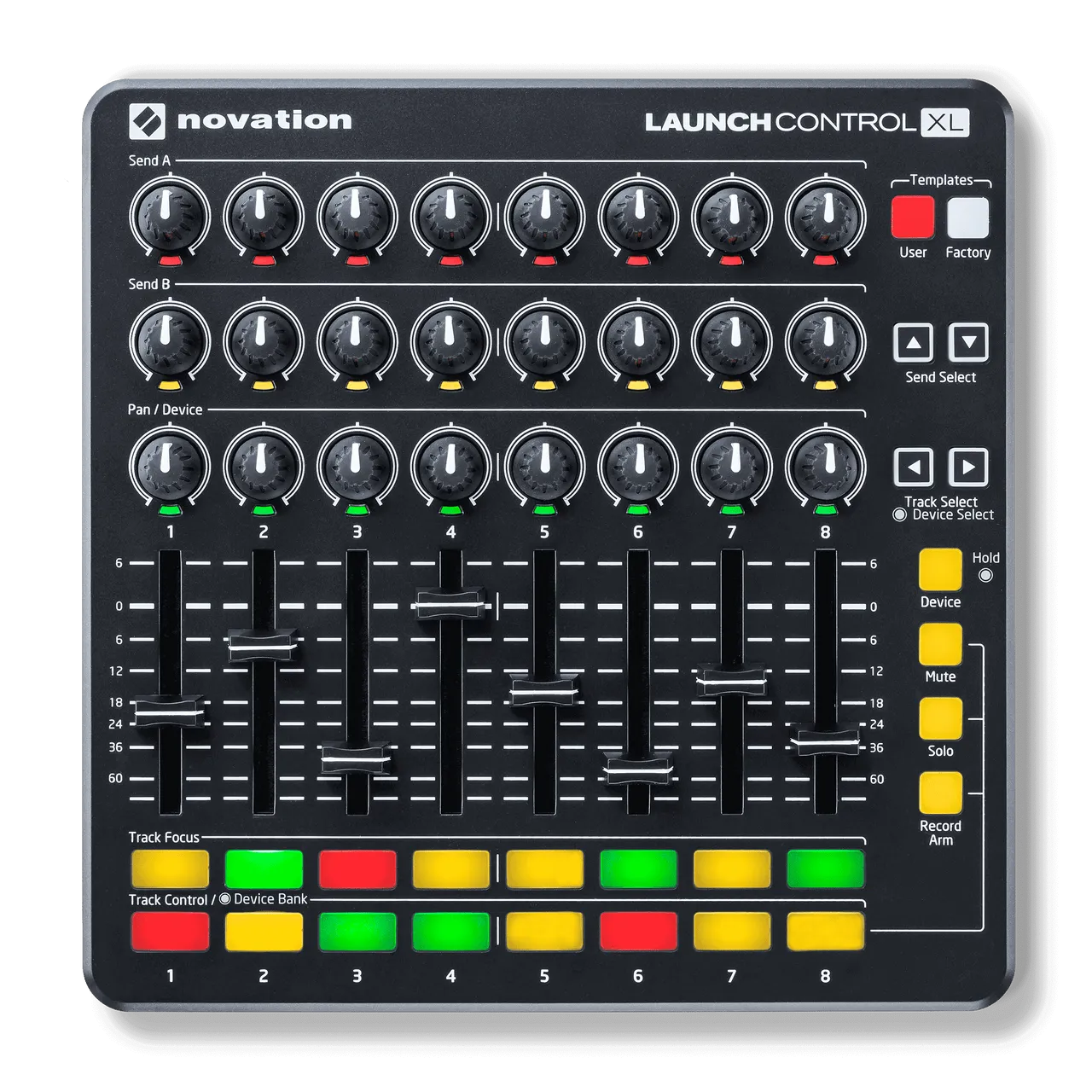
Specialized Controllers
- Features: These controllers are designed to emulate specific instruments, like wind or string controllers, offering unique expressive capabilities.
- Pros: They allow for nuanced performances that closely mimic those of the emulated instruments, ideal for specialized music production.
- Cons: Their specialized nature means they're less versatile for general music production tasks and cater to niche applications.
- Example: Artiphon Instrument 1

Nowadays, MIDI controllers offer a range of functionality. For instance, even the AKAI MPK Mini, a mini keyboard, offers pads and knob controls along with traditional note keys.
MIDI Keyboard Use Cases
MIDI keyboards have a broad range of applications in music production, from composing and arranging to live performance:
- Composing. Quickly input notes and chords into a DAW, making it easier to compose music digitally.
- Sound Design: Manipulate software synthesizers and effects in real time, allowing for creative sound exploration.
- Live Performance: Use MIDI keyboards to play virtual instruments on stage or trigger backing tracks and samples (Fred Again's infamous Boiler Room set is a perfect example of this).
- Education: Learn music theory and composition with visual aids and interactive software.
FAQs
What’s the difference between a MIDI keyboard and a synthesizer?
A MIDI keyboard is primarily a controller that sends data to a computer or sound module to trigger sounds or control software. It doesn't generate sound on its own.
On the other hand, a synthesizer has its own sound engine that creates audio signals. While some MIDI keyboards come with built-in synthesizer capabilities, the basic function of a MIDI keyboard is to control external sound sources.
Can I use a MIDI keyboard without a computer?
Typically, MIDI keyboards require a computer or sound module to generate sound, but some models can integrate with standalone hardware synthesizers or mobile devices.
Do I need a MIDI keyboard with a lot of controls?
It depends on your workflow. If you use a lot of virtual instruments and effects, additional controls like knobs, faders, and pads can be beneficial for hands-on control.
How do I connect a MIDI controller to my computer?
Most MIDI keyboards connect via USB and may require drivers or software to be fully functional. Some models also support MIDI connections for use with hardware synthesizers or interfaces.
Is a MIDI controller necessary for music production?
While not strictly necessary, a MIDI keyboard dramatically enhances the music production process by providing a tactile and intuitive way to input and manipulate music data.
What are weighted keys, and do I need them?
Weighted keys mimic the resistance and feel of an acoustic piano's keys, providing a more realistic playing experience.
Whether you need them depends on your playing style and preference.
If you're a pianist or aim to develop traditional piano skills, a MIDI keyboard with weighted keys can be very beneficial.
For producers focused more on beat-making or electronic music production, weighted keys might not be necessary.
How can I choose the right MIDI keyboard for my needs?
Consider your primary use cases (composition, live performance, beat-making), space availability, budget, and preferred workflow.
Opt for a keyboard with weighted or semi-weighted keys for intricate piano parts or classical training.
If portability or beat-making is your priority, a compact controller with mini keys and pads might be ideal.
Assess the need for additional controls like knobs and faders based on whether you'll use the keyboard for DAW control and mixing.



